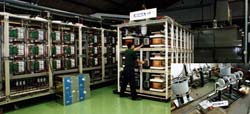Sources of energy for the EFDA-JET nuclear fusion experimental reactor

JEMA, the company based in Lasarte in the Basque Country, has recently put into operation the two energy supply plants designed and manufactured for the European EFDA (the European Fusion Development Agreement)-JET nuclear fusion experimental reactor at Culham in the United Kingdom. This reactor is one of the plants on which ITER, the largest research project in the world, has been based.
With this achievement JEMA has carried out more than 2 years of intense work in research, design and construction of equipment which is at the latest available technological cutting edge of what is possible in manufacturing today.
Each supply plant produces 20 million watts (approximately 10% of the energy produced at the power station at the Basque port of Pasaia) using 130,000 volts d.c. power supply at 130 amperes, with high quality and precision specifications: less than 1,000 volts of error; 150 microseconds rising ramp and 7 microseconds falling ramp.
To achieve the specifications required it has been necessary to develop a very wide variety of innovative elements and configurations (260,000 volt insulating transformers, crowbars, DSP control, refrigeration systems for water, etc.), which have required the joint working across a number of research centres.
Some interesting data: each energy supply installation occupies a surface area of approximately 400 m2 and needed 9 specialised lorries for their transport to the U.K. and the factory-based trials required a modification of its electric supply with new, high-tension cables being erected across the N-1 highway and over the river Oria.
The contract for these energy supply installations was awarded to JEMA by the European Commission, commissioned by EFDA and against keen competition from big multinationals in the sector. More than 25 years of international experience at JEMA developing specialised electrical supply equipment for nuclear and particle physics research laboratories has made this possible.
It is also worthy of mention the fact that in 2003 JEMA developed an plant prototype for the LHC (Large Hadron Collider) experiment, the world’s largest particle accelerator currently under construction at CERN (European Centre for Nuclear research), in Geneva (Switzerland).
Notes
More information:
Juan Otegi
Commercial Manager
jema@grupojema.com
tel: (+34) 943376400
Fax: (+34) 943371279
Media Contact
All latest news from the category: Power and Electrical Engineering
This topic covers issues related to energy generation, conversion, transportation and consumption and how the industry is addressing the challenge of energy efficiency in general.
innovations-report provides in-depth and informative reports and articles on subjects ranging from wind energy, fuel cell technology, solar energy, geothermal energy, petroleum, gas, nuclear engineering, alternative energy and energy efficiency to fusion, hydrogen and superconductor technologies.
Newest articles

Bringing bio-inspired robots to life
Nebraska researcher Eric Markvicka gets NSF CAREER Award to pursue manufacture of novel materials for soft robotics and stretchable electronics. Engineers are increasingly eager to develop robots that mimic the…

Bella moths use poison to attract mates
Scientists are closer to finding out how. Pyrrolizidine alkaloids are as bitter and toxic as they are hard to pronounce. They’re produced by several different types of plants and are…

AI tool creates ‘synthetic’ images of cells
…for enhanced microscopy analysis. Observing individual cells through microscopes can reveal a range of important cell biological phenomena that frequently play a role in human diseases, but the process of…





















